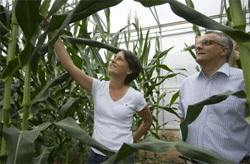Corn: More Active Genes in Roots Mean Higher Yields
Hybrid plants provide much higher yield than their homozygous parents. Plant breeders have known this for more than 100 years and used this effect called heterosis for richer harvests.
Until now, science has puzzled over the molecular processes underlying this phenomenon. Researchers at the University of Bonn and partners from Tübingen and the US have now decoded one possible mechanism in corn roots. More genes are active in hybrid plants than in their homozygous parents. This might increase growth and yield of the corn plants. The results are published in the renowned scientific journal Genome Research.

Credit: Barbara Frommann/Uni Bonn.
The world population continues to grow and needs to be fed. Cereals provide more than 70 per cent of human nutritional energy. Their yield increases significantly when plant breeders make use of the heterosis effect: “Heterozygous hybrids are significantly more vigorous than homozygous varieties” says Prof. Dr. Frank Hochholdinger, chair of Crop Functional Genomics at the University of Bonn. Heterosis can double the yield of grains like corn or rye. Hence, a hybrid corn cob is usually much larger than that of a homozygous plant.
Molecular Causes Elusive
Homozygous plants are a result of inbreeding depression: yield shrinks with every generation. Hence, most of the corn grown in Europe and the USA are hybrids. But why are hybrid plants more efficient than their homozygous relatives? “This effect has been known for over 100 years, yet its molecular cause remained unknown until now” reports first author Dr. Anja Paschold, associate of Prof. Hochholdinger at the Institute for Crop Science and Resource Conservation. The findings of the research team now support at a molecular level the complementation model hypothesized in 1917, which suggests that beneficial heritable characters from both parental lines complement deleterious or absent characters in the hybrid plant.
Transcripts Indicate the Status of Gene Activity
Researchers at the University of Bonn and their colleagues at Iowa State University and the Max Planck Institute for Developmental Biology in Tübingen compared gene activity in roots of young homozygous and hybrid corn plants. Transcripts provide the blueprints for important proteins. If a certain protein is required, a copy of the corresponding gene is made from the DNA in the nucleus of the cell. This copy of the gene – a ‘transcript’ – is used as a blueprint for producing the relevant protein. “Transcripts are present whenever the corresponding gene is active,” explains Prof. Hochholdinger. Researchers are now surveying all transcripts present in the cell to know which genes are active.
Researchers Doing Detective Work
“Our methods are similar to those of a crime scene investigator. We try matching transcripts – the ‘fingerprints’ – to the corresponding genes – the criminal records” says Prof. Hochholdinger. If a fingerprint is found, then it proves that the corresponding gene is active. “It’s just like a fingerprint found at a crime scene,” the biologist explains, “The investigators then know which individual must have been active on the scene.” High-throughput automatic sequencing machines at the Max Planck Institute for Developmental Biology in Tübingen helped to identify the gene transcripts. “Of the 39,656 known corn genes, close to 90% were active in the studied plants,” reports Dr. Paschold.
A Few Hundred Additional Genes are Active in Hybrid Plants
However, it has been demonstrated that in hybrids several hundred additional genes were active compared to the homozygous parental lines. The same number of genes is inherited from the two parental plants, however, their activity can differ in the mother and father plant. In hybrids, these different activities are combined. “Compared to the approximately 34,000 active genes the number of 350 to 750 genes that are additionally activated in hybrids is relatively small” says Prof. Hochholdinger, “And yet the small genetic contribution of each of these gene could significantly increase growth and vigor of hybrids.”
Practical Benefit for Plant Breeders
Researchers now want to find out more about the advantages that additional gene activity in hybrids could provide. These findings might provide practical benefits in the future. Until now, plant breeders use extensive field trials to find out which combinations of the thousands of various corn varieties result in efficient hybrids. “Our findings could result in a preselection that could reduce breeders’ efforts and expenses,” says Prof. Hochholdinger.
